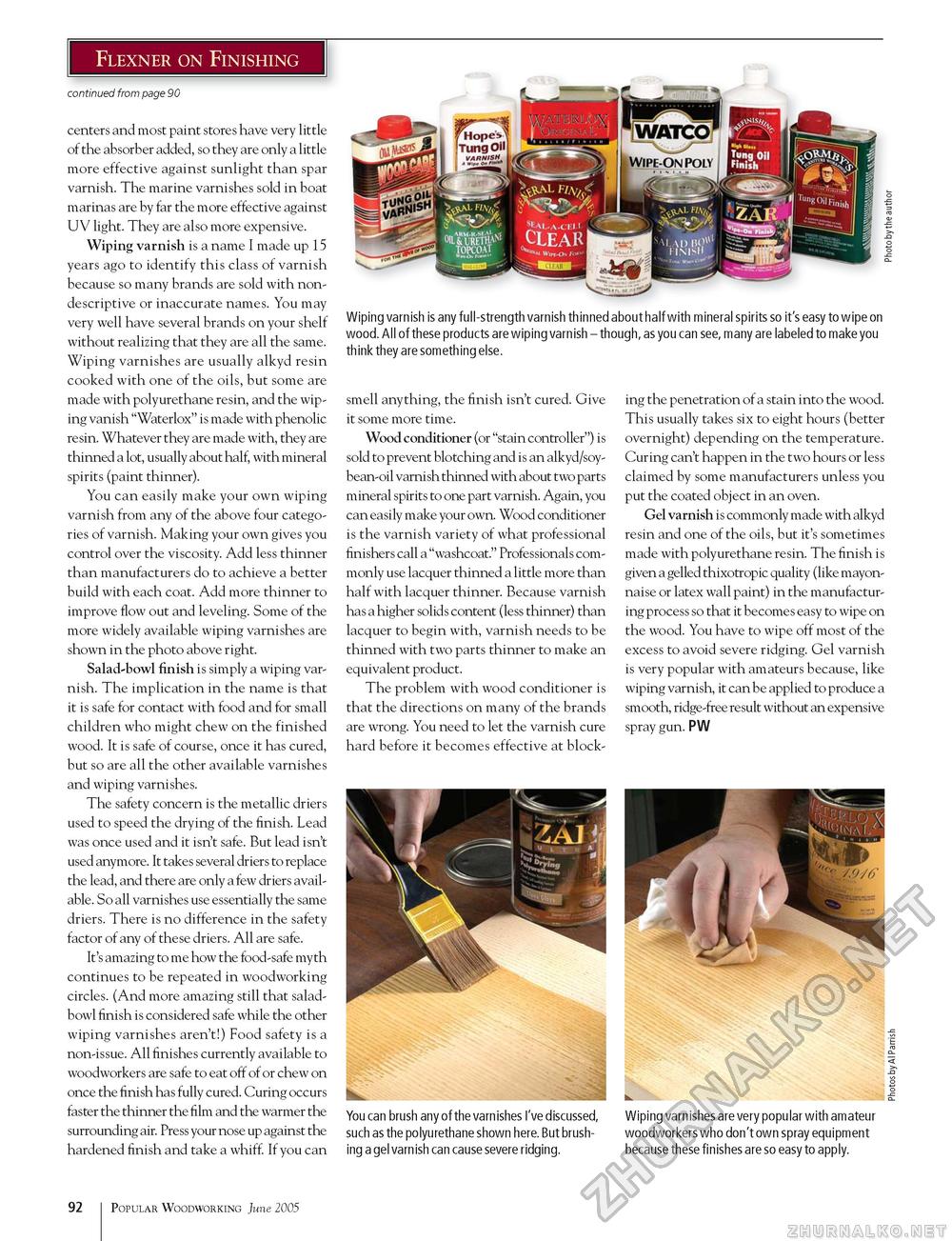Popular Woodworking 2005-06 № 148, страница 94
Flexner on Finishing continued from page 90 centers and most paint stores have very little of the absorber added, so they are only a little more effective against sunlight than spar varnish. The marine varnishes sold in boat marinas are by far the more effective against UV light. They are also more expensive. Wiping varnish is a name I made up 15 years ago to identify this class of varnish because so many brands are sold with non-descriptive or inaccurate names. You may very well have several brands on your shelf without realizing that they are all the same. Wiping varnishes are usually alkyd resin cooked with one of the oils, but some are made with polyurethane resin, and the wiping vanish "Waterlox" is made with phenolic resin. Whatever they are made with, they are thinned a lot, usually about half, with mineral spirits (paint thinner). You can easily make your own wiping varnish from any of the above four categories of varnish. Making your own gives you control over the viscosity. Add less thinner than manufacturers do to achieve a better build with each coat. Add more thinner to improve flow out and leveling. Some of the more widely available wiping varnishes are shown in the photo above right. Salad-bowl finish is simply a wiping varnish. The implication in the name is that it is safe for contact with food and for small children who might chew on the finished wood. It is safe of course, once it has cured, but so are all the other available varnishes and wiping varnishes. The safety concern is the metallic driers used to speed the drying of the finish. Lead was once used and it isn't safe. But lead isn't used anymore. It takes several driers to replace the lead, and there are only a few driers available. So all varnishes use essentially the same driers. There is no difference in the safety factor of any of these driers. All are safe. It's amazing to me how the food-safe myth continues to be repeated in woodworking circles. (And more amazing still that salad-bowl finish is considered safe while the other wiping varnishes aren't!) Food safety is a non-issue. All finishes currently available to woodworkers are safe to eat off of or chew on once the finish has fully cured. Curing occurs faster the thinner the film and the warmer the surrounding air. Press your nose up against the hardened finish and take a whiff. If you can Wiping varnish is any full-strength varnish thinned about half with mineral spirits so it's easy to wipe on wood. All of these products are wiping varnish - though, as you can see, many are labeled to make you think they are something else. smell anything, the finish isn't cured. Give it some more time. Wood conditioner (or "stain controller") is sold to prevent blotching and is an alkyd/soy-bean-oil varnish thinned with about two parts mineral spirits to one part varnish. Again, you can easily make your own. Wood conditioner is the varnish variety of what professional finishers call a "washcoat." Professionals commonly use lacquer thinned a little more than half with lacquer thinner. Because varnish has a higher solids content (less thinner) than lacquer to begin with, varnish needs to be thinned with two parts thinner to make an equivalent product. The problem with wood conditioner is that the directions on many of the brands are wrong. You need to let the varnish cure hard before it becomes effective at block- ing the penetration of a stain into the wood. This usually takes six to eight hours (better overnight) depending on the temperature. Curing can't happen in the two hours or less claimed by some manufacturers unless you put the coated object in an oven. Gel varnish is commonly made with alkyd resin and one of the oils, but it's sometimes made with polyurethane resin. The finish is given a gelled thixotropic quality (like mayonnaise or latex wall paint) in the manufacturing process so that it becomes easy to wipe on the wood. You have to wipe off most of the excess to avoid severe ridging. Gel varnish is very popular with amateurs because, like wiping varnish, it can be applied to produce a smooth, ridge-free result without an expensive spray gun. PW You can brush any of the varnishes I've discussed, Wiping varnishes are very popular with amateur such as the polyurethane shown here. But brush- woodworkers who don't own spray equipment ing a gel varnish can cause severe ridging. because these finishes are so easy to apply. 92 Popular Woodworking June 2005 |








